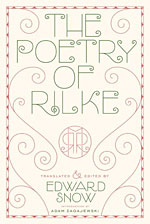Rilke has had plenty of remarkable translators, most famously, Stephen Mitchell. All have produced fine versions of Rilke’s unrelentingly intense and sculptural poems, but only Edward Snow has tuned his ear to most or all of Rilke’s body of work. Snow, a scholar at Rice University, has translated more of Rilke into English than anyone else—almost all of his major collections, The Book of Images, both volumes of New Poems, Duino Elegies, and Sonnets to Orpheus, as well as the revelatory Uncollected Poems; in so doing, he has become Rilke’s best and most important ambassador to American readers. At last, healthy selections from all of these books are available in a single bilingual doorstopper which is sure to be the standard Rilke in English for a long time.
For Rilke, everything visible is a frustrating mirror. The world taunts him, induces a longing to be more real, get closer, get out of his own way. “You must change your life,” says the world, as do both Mitchell and Snow, who translate the famous concluding sentence of “Archaic Torso of Apollo” in exactly the same way. It’s a small difference in the poem’s preceding line that sets the two translators apart and shows that Snow understands Rilke better. Here is Mitchell’s final stanza of “Archaic Torso,” which recalls an ancient statue of the titular god, missing its arms, legs and head. The statue
would not, from all the borders of itself,
burst like a star: for here there is no place
that does not see you. You must change your life.
Here is Snow’s final stanza, in which the statue’s life would:
… not break from all its contours
like a star: for there is no place
that does not see you. You must change your life.
To be fair, “all the borders of itself” is perhaps better, less awkward and more vivid, than Snow’s “from all its contours.” But the crucial difference is that Mitchell says, “here there is no place / that does not see you.” Snow omits the word “here” because he understands that for Rilke it is not merely the statue but everything in sight that demands change.
This sense of the whole world as overwhelming yet inaccessible suffuses all of Rilke’s poetry, nowhere more beautifully than in “The Spanish Trilogy” from The Uncollected Poems:
Why must a man stand here like a shepherd—
so exposed to excess of influence,
involved so in this space full of happening
that, merely leaning against a tree in the landscape,
he’d have his fate, nothing else to do.
This is Rilke at his most expansive and philosophical, and Snow renders the lines with a limpid intensity, like thought unfolding. Rilke’s shepherd is like Emerson’s “transparent eyeball,” taking everything in, but also like the statues of Rilke’s mentor Rodin, which seem to burst from their bronze because the world is too much to contain.
Finally, the Duino Elegies figure human consciousness as barring us from joining with reality. In “The Eighth Elegy,” Rilke imagines animals as less cut off: “With all its eyes the animal world / beholds the Open.” We, on the other hand, train ourselves to stay stuck inside our skulls: “. . . from the first we take a child / and turn him around and force him to gaze / backward and take in structure, not the Open.” It is that “structure,” words that are too narrow to frame the vastness of experience, that Rilke hopes to reveal in his poems. In Snow’s hands, Rilke becomes clear as glass—as if the poems could be windows opening onto the world, rather than mirrors that show us ourselves obstructing the view.








